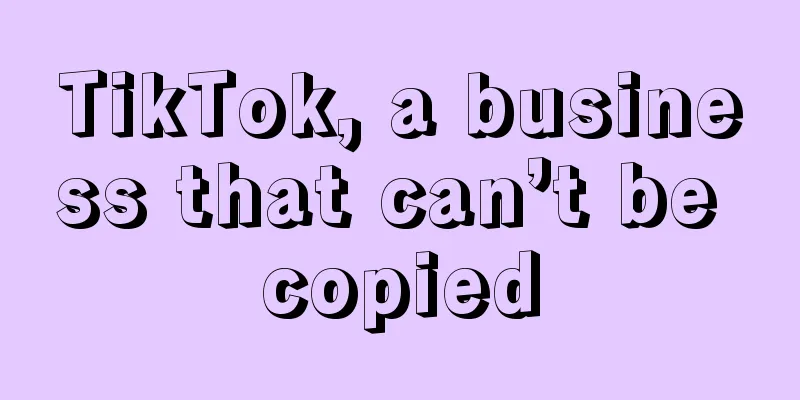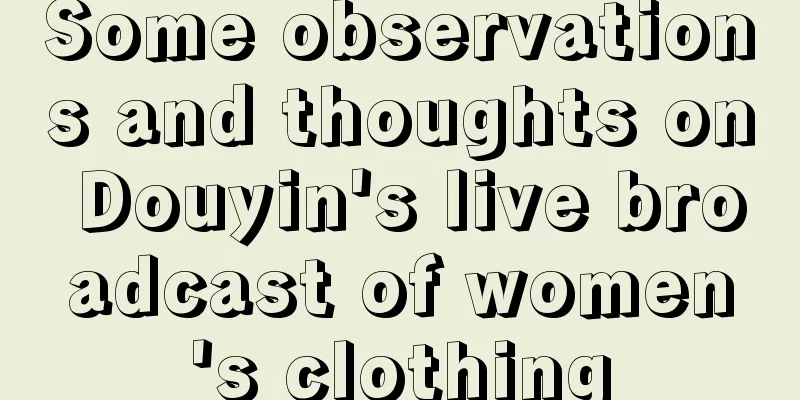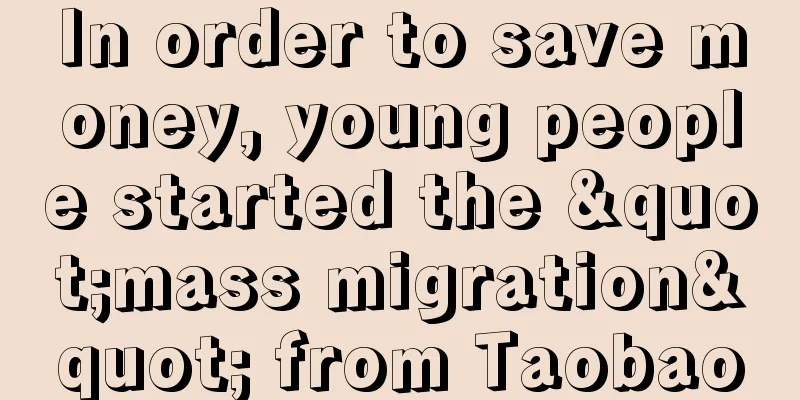TikTok, a business that can’t be copied

There is a Chinese idiom called "a tall tree attracts the wind", which is quite appropriate to describe TikTok's situation overseas. TikTok has more than 1 billion monthly active users worldwide, most of whom are young users. It can be said that it holds the future social discourse power and purchasing power. This has made many global social platforms and even e-commerce platforms anxious.
These Internet giants are all targeting TikTok in a unified manner, but they still look like inconspicuous little soldiers. Logically speaking, TikTok’s product logic is not difficult to “copy”—— 15-second short videos, vertically scrolling information feeds, and algorithm recommendation mechanisms are all open secrets. But why are overseas technology giants still not good at “copying”? Perhaps, besides algorithms, TikTok is also superior in time. 1. Facebook, the “little devil”Facebook, the global social giant, naturally cannot tolerate TikTok, a newcomer that is competing with it for young users. In 2014, Facebook and its apps had 71% of young users; but by 2018, that number had dropped to 50%. Facebook took the lead in launching the independent short video app Lasso , which is fully comparable to TikTok—— 15-second short videos, vertical screen, full-screen mode, popular tags, recommendation algorithm, youthful and entertaining. But the story did not go as expected , and Lasso's downloads were unexpectedly low. According to data from app research company Sensor Tower, Lasso had only nearly 70,000 downloads in the United States within four months of its launch in November 2018. This number is totally incomparable to TikTok. According to the same data from Sensor Tower, TikTok's global downloads in Q4 2018 were 206 million. As a result, Lasso closed down after one and a half years of operation. What does Facebook lose at this point? In terms of traffic, there is traffic; in terms of technological strength, there is technological strength. One of the key factors for the loss may be the big country market that is slower than TikTok. One is the US market. Lasso was launched in late 2018, when TikTok (then known as Musical.ly) had already established a certain user base in the U.S. TikTok's first-mover advantage enabled it to attract and retain a large number of young users, while Lasso, as a latecomer, found it difficult to catch up in a short period of time. The second is the Indian market. From the beginning of 2019 to the end of February 2020, Lasso has provided services in Colombia, Mexico, the United States, Argentina, Chile, Peru, Panama, Costa Rica, El Salvador, Ecuador and Uruguay, but they are all limited to the Americas. When Lasso was finally about to enter the Indian market, it found that it was difficult to pry into TikTok's market share. TikTok was the first to enter the Indian market, a country with the world's second largest and fastest-growing Internet user base, supporting 10 Indian languages and attracting a large number of young Indians. TikTok entered India at the perfect time, just in time when India's Internet rates were falling. At a time when mobile Internet was rapidly popularizing in India, short videos, a new social model, were also quickly popularized. People in India feel that apps like Facebook and Snapchat are more targeted at people living in big cities, while TikTok is more down-to-earth and can bring more fun to people living in small towns. As of August 2019, TikTok was installed on one-third of smartphones in India; at the same time, Indians spent more time on TikTok than people in any other country except China. Facebook's Lasso had difficulty taking off, and there were other factors as well: For example, the content creator ecosystem is not good enough; it lacks uniqueness and is difficult to attract users who are already familiar with TikTok; and other Facebook products are also trying short video features, further diluting Lasso's market positioning. But in the final analysis, if you miss the opportunity in some markets, you will get half the result with twice the effort. 2. TikTok’s “twists and turns” in going globalAlthough TikTok went global quickly, accurately and ruthlessly, it still couldn’t withstand one “ban” after another: Including India, Indonesia (banned for only two months), the United States, Canada, and the European Union (the United States/Canada/Europe currently only allows government employees to use TikTok on their phones). In 2020, TikTok suffered a setback in the Indian market. In June 2020, India announced a ban on TikTok, which was a pity for the market share advantage it had already won. As of May 2020, TikTok has been downloaded 611 million times in India, accounting for 30.3% of the global total. In addition, it is reported that TikTok has 200 million users in India, of which 120 million are active users per month. The latest news is that ByteDance (TikTok's parent company) is looking for new partnerships in India. It is reported that it has held preliminary negotiations with the Hiranandani Group, a leading Indian real estate developer, and Indian government officials have informally participated in the plan. However, there has been no new developments since the news came out in June 2022. Naturally, this golden time difference will not be left behind by major competitors. Instagram, owned by Facebook, launched Reels, a short video function built into the app, imitating TikTok in all aspects and trying to seize TikTok's market share once again. This time, Instagram learned more and chose to enter the Indian market as the first batch. Statistics from Similarweb show that on June 30, 2020, the day after TikTok and 58 other Chinese apps were banned in India, Instagram's daily downloads exceeded one million for the first time, reaching 1.6 million. India’s local short video platforms, such as Roposo, Chingari, Trell, and Mitron, have all seen rapid growth in the number of users within a few weeks. For example, Chingari gained 10 million users in just three weeks. However, TikTok cannot be easily replaced. Although Instagram actively promoted Reels, it failed to cultivate the habit of users to post short videos on Instagram. According to data from the influencer marketing platform HypeAuditor, only 22% of influencers on Instagram posted Reels short videos. In the process of trying to shift the platform from photo sharing to full-screen videos, Instagram also encountered user dissatisfaction, forcing Instagram to change its strategy. India's local short video platforms also lost in terms of product quality. Although many Indian users support local software, they still have to complain about its unaesthetic UI interface and frequent downtime. As for whether TikTok can make a comeback in the Indian market and when it will return, it will to a certain extent determine how long these short video players who "take advantage of the fire" will have to struggle. 3. If we return to the Indian marketIf TikTok regains the Indian market, it means that ByteDance has successfully gained access to the three most populous countries, China, the United States, and India, in the field of short videos. In China, ByteDance has created an unparalleled short video advantage (except for Kuaishou) through Douyin, quickly attracted fans through variety show cooperation, and launched live broadcast and e-commerce functions, further enriching the platform's commercialization channels; In the United States, ByteDance has rapidly advanced its globalization strategy by acquiring Musical.ly, which has a large user base overseas (especially in the United States and Europe) and has a Chinese background but is registered and operated in the United States. In India, ByteDance entered the Indian market faster than other competitors such as Facebook, covering multiple local languages and taking the lead in forming a huge user base. Behind the traffic is the population. Behind the traffic that TikTok is proud of are the population bases supported by these countries - China's population of 1.41 billion (2023), the United States' population of 333 million (2022), and India's population of 1.417 billion (2022), which together form a market of 3.16 billion, accounting for about 40% of the world's population. Behind the refined traffic is the power of algorithms. The charm of algorithm recommendation may lie in its ability to match massive amounts of content with users, to perform localized operations across cultural and language boundaries, and to allow users to decide for themselves what videos to watch and what are good videos. Then one hit after another was born, forming a popular culture that spontaneously emerged from the grassroots. As TikTok enters more countries, the intersection and collision of diverse pop cultures originating from the grassroots will have a greater influence, making the TikTok platform more competitive and irreplaceable. Final ThoughtsTikTok's content is mostly music, dance, fashion and lifestyle, which does not mean that it can provide irreplaceable high-quality content. However, TikTok has seized the largest market share of short videos in the world at the fastest speed and covers the most users, which is enough to prevent it from losing its competitiveness quickly even in the face of one "executive ban" after another. Users do not want to give up the browsing habits that have been cultivated by the algorithm, and Internet celebrities do not want to give up the careers they have been working on for some time. Therefore, even if other competitors copy the product logic, they cannot copy TikTok's already consolidated first-mover advantage. At this moment, TikTok is still expanding its business territory—— Including but not limited to Europe, Japan, Southeast Asia, Russia, etc. According to datareportal, as of April 2022, TikTok has 99.1 million active users in Indonesia, 73.6 million active users in Brazil, 51.3 million active users in Russia, and 50.5 million active users in Mexico (data refers to the number of active users aged 18 and above). And through TikTok shop, it continues to develop content e-commerce, not only becoming a strong competitor to existing e-commerce giants such as Shopee and Lazada in Southeast Asia, but also a challenger to Amazon in the United States and the Middle East. The current share of e-commerce is not large, but its growth rate is fast enough. Especially in the Southeast Asian market, TikTok shop's market share tripled from 4.4% in 2022 to 13.2% in 2023. Amid the turmoil in the short video market, TikTok is like a sharp eagle in the night, identifying the best time with its sharp eyes, and capturing its prey in the first time with a "fast, accurate and ruthless" attitude. Now, in the territory where TikTok is temporarily "banned", competitors are fighting fiercely. Let's see when the Eagle will return, return to the territory it has already occupied, and clean up the market structure again. Author: Vinky, WeChat public account: Sanyanliangyu. |
>>: WeChat official version suddenly updated! This New Year limited function is really fun
Recommend
Why do consumers hesitate when faced with purchasing decisions?
Sometimes, when faced with the same product, diffe...
Why are life-related content more popular among video account users?
Among many video platforms, Video Account has attr...
Is “Healthy Milk Tea” a tax on your IQ?
Health preservation for college students, health p...
Xiaohongshu has been revamped again! What does it mean for brands?
Xiaohongshu changed the "shopping" optio...
How long does it take for Amazon FBA to enter the warehouse? What should I do if the warehouse is out of stock?
Amazon is a very fair platform, which is also one ...
Is Lazada's cross-border e-commerce business easy to do? What are the prospects?
Among the cross-border e-commerce platforms, Lazad...
Is the money spent by brands on skit marketing worth it? A set of data can help you quickly sort out your thoughts
As an emerging marketing method, short drama marke...
The ticket is 40 yuan and the surrounding area is 800 yuan. Hongshan Zoo is really good.
Nanjing Hongshan Forest Zoo has become popular on ...
How to link cross-border e-commerce? How to operate well?
With the development of globalization, cross-borde...
First-hand data to interpret new business opportunities in the sinking consumer market
This article provides data insights into the sinki...
Meituan Tuanmaimai ceases operations. Let me tell you my expectations for WeChat e-commerce
Meituan Tuanmaimai has ceased operations, and the ...
What should I do if I cannot log into Amazon Seller Central? Why?
After Amazon merchants open a store, if there is a...
Is the Allegro cross-border e-commerce platform real or fake? How do cross-border e-commerce platforms combat counterfeit goods?
When choosing the right platform, consumers often ...
What should I do if I don’t know English when opening a store on Amazon?
For merchants who do not understand English, langu...
Super anchor's trust game
With the rise of the e-commerce industry, super an...









